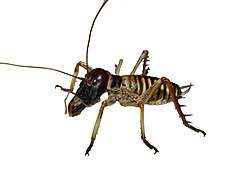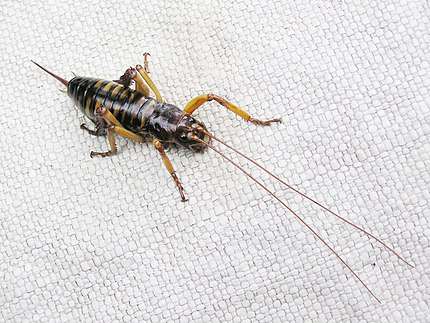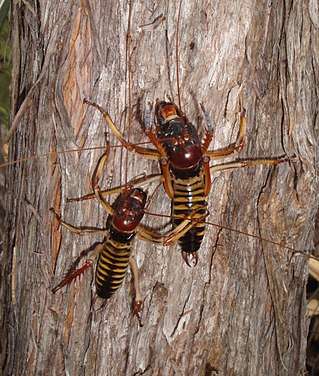Hemideina crassidens
| Hemideina crassidens | |
|---|---|
 | |
| Female | |
 | |
| Male | |
| Scientific classification | |
| Kingdom: | |
| Phylum: | |
| Class: | |
| Order: | |
| Suborder: | |
| Family: | |
| Genus: | |
| Species: | H. crassidens |
| Binomial name | |
| Hemideina crassidens (Blanchard, 1851) | |
| Synonyms | |
| |
Overview
Hemideina crassidens, commonly known as the Wellington tree wētā, is a large, flightless, nocturnal insect in the family Anostostomatidae. This wētā species is endemic to New Zealand and populates regions in the southern half of North Island/Te Ika a Maui and the north-west of the South Island/Te Wai Pounamu. They forage arboreally during the night and are most likely polyphagous. There is obvious sexual dimorphism in adults. Individuals are reliant on tree cavities for refuge, social interactions and mating.
The conservation status of H. crassidens is "not threatened".
Distribution and habitat
Hemideina crassidens is endemic to New Zealand.[1] Populations are distributed between the Ruapehu district and Wellington district of the North Island, and in the Westland district of the South Island.[1][2][3] A closely related native tree wētā, Hemideina thoracica, is widely distributed in the northern two-thirds of the North Island New Zealand.[4] It has been suggested that H thoracica competitively excludes H. crassidens from warmer northern regions of the North Island.[4] On Mt Taranaki, H. crassidens is found only at elevations above ~700 m asl, and H. thoracica is found lower down the slopes where temperatures are slightly warmer.[2][4]
Hemideina crassidens is a nocturnal and arboreal.[1] This species uses holes in tree branches to hide during the day.They usually live in tree holes, suggesting a reliance on forest. However, many extant tree wētā populations occupy scrub habitats or even use rock refuges when trees are not available.[5]
Climate change
In the central North Island populations of H. crassidens have become isolated within areas mostly populated by H. thoracica suggesting previous range contraction due to interactions with competitors and the environment.[4] This contraction is likely to continue southwards during global warming, resulting in the displacement of H. crassidens from many lowland areas of central and southern North Island.[4]
Diet
Being a tree wētā, H. crassidens spend most of their time foraging arboreally.[1] They are generally herbivorous, feeding on the leaves, fruit and flowers of a wide range of trees and shrubs.[1][6] However, polyphagy is common among wētā species and it is likely that H. crassidens supplement their diet with animal matter.[6] Individuals have been documented feeding on living or recently dead invertebrates.[7]
Morphology

Hemideina crassidens are relatively large at maturity (> 6.5 cm body length).[7] Their bodies are smooth and shiny, the abdomen is ringed with bands contrasting bands of dark brownish to black and yellow, with a pale underside.[7] This colouration is reminiscent of uniform of the Wellington rugby team, the Hurricanes, and can be used to distinguish it from the Auckland tree wētā (Hemideina thoracica). They have heavily spined hind tibiae that are used in defence postures.[7][8] The antennae are long and mobile to help with sensing and navigation, particularly in the dark.[1] The Wellington tree wētā and the Hawkes Bay tree wētā (Hemideina trewicki) look the same but have different numbers of chromosomes[9]. In South Island H. crassidens have 19 (male) or 20 (female) chromosomes and in North Island this species has 15 or 16 chromosomes[10]. The Hawkes Bay tree wētā has 17 (male) or 18 (female) chromosomes[9].
Sexual dimorphism
Males display highly exaggerated, positively allometric mandibles.[11][12] Accelerated maturation of males gives rise to three different head sizes that correlate their maturation on either the 8th, 9th or 10th instar.[11] 8th instar males have small heads, 10th instar males have particularly elongated jaws and a large vertex and 9th instar males have an intermediate from.[12][7][11] Females only reach maturity at the 10th instar.[11] In this wētā species, females can be identified by their small head and long ovipositor.[7]


Galleries

Rather than bore their own tree holes, H. crassidens inhabit natural crevices and cavities, or pre-existing tunnels that have been excavated by large wood-boring larva such as Ochroydus hutoni (Coleoptera: Cerambycidae) or Aenetus virescens (Lepidoptera: Hepoalidae).[7] They prefer tree holes in living timber and avoid fallen or rotten logs.[13] Native trees and shrubs such manuka (Leptospermum scoparium), kanuka (Kunzea ericoides), ngaio (Myoporum laetum), kohekohe (Dysoxylum spectabile) and mahoe (Melicytus ramiflorus) are favoured by H. crassidens.[13] Suitable galleries have a narrow entrance hole (~20mm in diameter) in order to provide protection from predators such as birds.[14] The holes are entered head first and exited in reverse so that the spines on their hind tibiae point outwards to defend from intruders.[14][7] Inhabited galleries can often be identified by the neatly nibbled entrance which is kept clean.[7] Individuals often occupy the same gallery for an extended period of time.[15] Galleries buffer against environmental variation, especially humidity.[15][7]
Breeding
Hemideina crassidens is a polygynous insect in which males guard females that reside in tree cavities termed 'galleries'.[11][12] Galleries are used for breeding and males compete for control of them and access to the females within.[11][13] Male head size is an indicator of combative ability as the head is used as weaponry in combat for dominance and control of a harem.[11] In cases where the gallery is sufficiently large, multiple males can occupy a single gallery, suggesting that a dominant male defends a harem rather than a gallery per se.[11] Males can avoid combat by facing off, opening their jaws and assessing the gape of their opponent’s mandibles.[8][11] In a non-violent contest the male whose mandibles span the furthest is considered dominant.[11][12] Small headed males can mate by wandering nocturnally and copulating with females outside of a gallery, or by sneaking into a gallery occupied by a dominant male and copulating with females within.[7] A small headed male is able to control a harem within a gallery if the entrance is too small for large headed males to fit through.[11][12]
Most matings and ovipositions occur over the summer and autumn.[7][1] Females lay their eggs vertically in the soil approximately 10mm under the surface.[1][7] Hatching occurs in spring and individuals take about 18 months to become mature, reaching sexual maturity in the following summer.[1] Hemideina crassidens do not show any parental care.[7] Their normal lifespan is about 3 years, with about 18 months as immatures.[7]
Conservation
The number of suitable galleries in an area is considered to be a major limiting resource of H. crassidens.[16][13] The construction and distribution of artificial refuges has been suggested as a possible conservation strategy to try and increase populations of H. crassidens and H. thoracica.[17]
The conservation status of H. crassidens is "not threatened".[18]
References
- Gibbs, George (2003). The Weta, New Zealand Wild. Reed Publishing. ISBN 978-1869486044.
- Trewick, S.A; Morgan Richards, M (1995). "On the distribution of tree weta in the North Island, New Zealand". Journal of the Royal Society of New Zealand. 25 (4): 1–9.
- Pratt, Renae C; Morgan-Richards, Mary; Trewick, Steve A (27 October 2008). "Diversification of New Zealand weta (Orthoptera: Ensifera: Anostostomatidae) and their relationships in Australasia". Philosophical Transactions of the Royal Society B: Biological Sciences. 363 (1508): 3427–3437. doi:10.1098/rstb.2008.0112. ISSN 0962-8436. PMC 2607373. PMID 18782727.
- Bulgarella, M. Trewick SA, Minards NA, Jacobson MJ, Morgan-Richards, M (2014). "Shifting Ranges of Two Tree Weta Species (Hemideina Spp.): Competitive Exclusion and Changing Climate". Journal of Biogeography. 41 (3): :524–535. doi:10.1111/jbi.12224.CS1 maint: multiple names: authors list (link)
- "View of Use of rock crevices as refuges by the tree weta Hemideina femorata Hutton 1897 (Orthoptera: Anostostomatidae) at Mt Cass, Canterbury". publications.ento.org.nz. Retrieved 22 June 2018.
- Griffin, M.J, Morgan-Richards, M, Trewick, S.A, Griffin, M.J; Morgan-Richards, M; Trewick, S.A (2011). "Is the tree weta Hemideina crassidens an obligate herbivore?" (PDF). New Zealand Natural Sciences. 36: 11–19.CS1 maint: multiple names: authors list (link)
- Field, L.H (2001). The Biology of Wetas, King Crickets and Their Allies. New York: CABI Publishing. ISBN 978-0851994086.
- Ordish, R.G. (1992) Aggregation and communication of the Wellington weta Hemideina crassidens (Blanchard) (Orthoptera: Stenopelmatidae). New Zealand Entomologist 15: 1–8.
- Mckean, N. E.; Trewick, S. A.; Morgan-Richards, M. (2015). "Comparative cytogenetics of North Island tree wētā in sympatry". New Zealand Journal of Zoology. 42 (2): 73–84. doi:10.1080/03014223.2015.1032984. ISSN 0301-4223.
- Morgan-Richards, M (2000). "Robertsonian translocations and B chromosomes in the Wellington tree weta, Hemideina crassidens (Orthoptera: Anostostomatidae)". Hereditas. 132: 49–54. doi:10.1111/j.1601-5223.2000.00049.x.
- Kelly, Clint D. (1 January 2008). "Identifying a causal agent of sexual selection on weaponry in an insect". Behavioral Ecology. 19 (1): 184–192. doi:10.1093/beheco/arm121. ISSN 1045-2249.
- Kelly, Clint D. (18 August 2004). "Allometry and sexual selection of male weaponry in Wellington tree weta, Hemideina crassidens". Behavioral Ecology. 16 (1): 145–152. doi:10.1093/beheco/arh141. ISSN 1465-7279.
- Field, L.H.; Sandlant, G.R. (2001) The gallery-related ecology of New Zealand tree wetas, Hemideina femorata and Hemideina crassidens (Orthoptera, Anostostomatidae). Pp. 243–258 in Field, L.H. (Ed.): The biology of wetas, king crickets and their allies. CABI Publishing, Oxon.
- Field, L. H.; Rind, F. C. (1992). "Stridulatory behaviour in a New Zealand weta,Hemideina crassidens". Journal of Zoology. 228 (3): 371–394. doi:10.1111/j.1469-7998.1992.tb04442.x. ISSN 0952-8369.
- Field, L.H.; Sandlant, G.R. (1983) Aggression and mating behaviour in the Stenopelmatidae (Orthoptera; Ensifera), with reference to New Zealand wetas. Pp. 120–146 in Gwynne, D.T.; Morris, G.K. (Eds): Orthopteran mating systems. Sexual competition in a diverse group of insects. Westview Press, Boulder, Colorado, USA.
- Rufaut, Catherine G.; Gibbs, George W. (2003). "Response of a Tree Weta Population (Hemideina crassidens) After Eradication of the Polynesian Rat from a New Zealand Island". Restoration Ecology. 11 (1): 13–19. doi:10.1046/j.1526-100x.2003.00058.x. ISSN 1061-2971.
- Bleakley C, Stringer I, Robertson A, Hedderley D (2006) Design and use of artificial refuges for monitoring adult tree weta, Hemideina crassidens and H. thoracica. Doc Research & Development series 233. Published by Science & Technical Publishing Department of Conservation PO Box 10–420 Wellington, New Zealand. ISSN 1176-8886 ISBN 0-478-14062-2
- Trewick S, Morris S, Johns P, Hitchmough R, Stringer I (2012). The conservation status of New Zealand Orthoptera. New Zealand Entomologist. 35. 10.1080/00779962.2012.686318.
External links
| Wikimedia Commons has media related to Hemideina crassidens. |
| Wikispecies has information related to Hemideina crassidens |